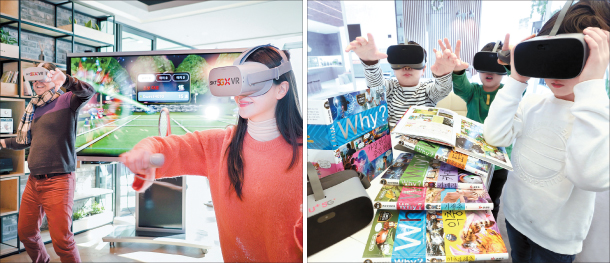Technology in search of purpose

Left: Models enjoy a tennis game in Crazy World VR, a co-developed virtual reality (VR) game by SK Telecom, Nexon and Pixelity Games. Right: Children wear head-mounted display (HMD) glasses to experience the “Why?” series of VR content provided by LG U+. [SK TELECOM, LG U+]
Only 15 percent of Korean cell phone users were 5G subscribers by the end of last year, while most users were simply streaming videos. The ultrahigh speed, ultralow latency and hyper-connectivity that define 5G were just not being used that much.
The dismal stats have the three mobile phone companies scrambling to find uses for the new technology, investing heavily in augmented reality (AR) and virtual reality (VR) content.
Their goal is to double the percentage of 5G users to 30 percent of the total mobile users.
LG U+ plans to invest 2.6 trillion won ($2.2 billion) over the next five years in developing AR and VR content. Its ambitious plans include opening a second studio in the first half of this year to develop programing.
LG U+ opened its U+ AR Studio last year. It has 45 servers and film lighting that allows it to simultaneously film with 30 4K video cameras. LG U+ also signed an exclusive partnership with Los Angeles-based 8i to make AR content with 8i’s volumetric video technology to capture high-definition video from 360 degrees.
SK Telecom will open its digital content production studio, named Jump Studio, next month. Through a contract with Microsoft, SK Telecom will utilize the company’s mixed reality capture studio technology to create realistic images for the 5G era.
At present, three types of programs are being made with VR and AR technology: educational, entertainment and therapy.
By experiencing virtual space or spaces difficult to visit, such as under the sea, AR and VR allow a greater sense of engagement.
LG U+ and the Ministry of Education teamed up to create realistic education models that provide AR and VR field trips to experience cultural assets, tourist attractions, animals and plants found in textbooks.
SK Telecom formed artificial intelligence (AI)-based education technology start-up Marvrus and VR English-language learning service Speakit. By wearing the head-mounted display (HMD) glasses, users can speak with virtual characters in English in various situations, such as at restaurants, airports and conference rooms in foreign countries.
VR and AR are also used in the entertainment sector, such as for games, sports events and concerts.
“This is the most popular area in AR and VR content,” Kim Il, director of the Korea VR AR Industry Association and CEO of gaming company Maniamind, said.
“Until last year, it was only for the early adopters, but now the fast followers are joining the stage to expand the client base.”
KT released the VR Music “VP album” that allows viewers to experience an idol’s stage performance in ultrahigh-definition at 1.5 million pixels through 360-degree 8K VR technology. Users can make eye contact an idol or enjoy the performance while on the virtual stage.
SK Telecom and Microsoft have been offering Project xCloud since last October, in which a player can access high-definition and large-capacity Xbox games on a smartphone.
SK Telecom also co-developed a VR game called Crazy World VR with Nexon and Pixelity Games, in which 50 users can play four different mini games - shooting, archery, tennis and bowling - at the same time.
Another application of VR and AR is within the therapy industry.
SK Telecom collaborated with psychiatry specialists from Yongin Severance Hospital to produce 12 VR videos, called “Mindfulness,” which can reduce stress.
By wearing HMD devices and following the voice prompts, users can meditate in a peaceful natural setting to calm background music.
“The characteristics of AR and VR content is immersion in another world,” Choi Soo-mi, a professor of computer science at Sejong University, said. “For the those who are in pain or depressed, realistic content can be an effective prescription to forget the pain or to give a sense of security and enjoyment.”
Although the telecom companies are making continuous efforts to popularize AR and VR content, there are still many limitations.
“Although 5G is important, the price of HMD hardware is above the commercialization level,” Kim said. “On top of its expensive price, the quality of HMD equipment is still low. The users’ motion sickness needs to be addressed as well.
“There may be emotional side effects such as struggling to break out from the virtual world and escaping from reality,” said Kwak Keum-joo, a psychology professor at Seoul National University.
“Since the new IT technology is a double-edged sword, experts in each field must discuss before commercializing the contents,” Kwak added.
BY PARK HYUNG-SOO [kim.yeonah@joongang.co.kr]










with the Korea JoongAng Daily
To write comments, please log in to one of the accounts.
Standards Board Policy (0/250자)